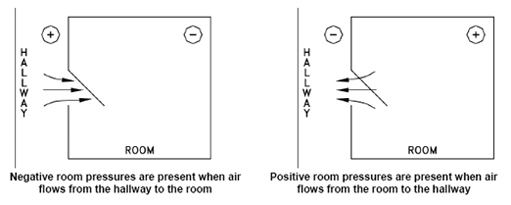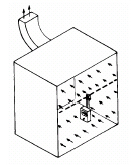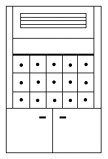Differential Pressure Measurement Between Two Rooms or Areas
Room pressures can be measured using a micromanometer to determine if one room is at a different pressure than an adjacent room or hallway. Isolation rooms in hospitals, for example, maintain a negative pressure differential in relation to an anteroom or corridor in order to contain the spread of infectious or contagious diseases.

Spray Booths
There are a number of applications in industrial plants which require airflow measurements at exhaust openings to satisfy minimum requirements for comfort or safety. The most common is a spray booth where the generally acceptable average velocity is 100 fpm (0.51 m/s) and air must be movingintothe booth at that velocity. An exhaust fan connected to the spray booth duct creates a negative pressure in the booth, resulting in ambient air outside the booth being drawn into the booth to mix with the vapors. The combined air mix then flows up the exhaust duct.A thermo-anemometer with a telescopic articulated probe, deflecting vane anemometer with a low-flow probe, rotating vane anemometer, or velocity matrix can be used to test spray booths.
• A thermo-anemometer with an averaging feature and datalogging is best suited for this type of measurement.
• The velocity matrix will produce the quickest results.

Divide the hood face into
a grid with 1 ft2
(0.09 m2) sections and take a reading in the center of each. Add the readings
and divide by the total number of readings to obtain the average face velocity.
Laboratory Hoods
Laminar flow benches and laboratory chemical fume hoods typically have average face velocities in the range of 100 to 120 fpm (0.51 to 0.61 m/s) in which no individual face velocity measurement can vary more than 20 percent from the average. This is necessary to ensure the safety of the hood user and to prevent unwanted contaminants from escaping the confines of the hood.The hood opening is divided into a grid pattern with one square foot sections. The instrument probe is positioned in the center of each section to obtain a reading. When all the measurements have been taken, they are added and divided by the total number of readings to obtain an average velocity. American Society of Heating, Refrigerating and Air-Conditioning Engineers (ASHRAE) Standard 110 has more detailed information pertaining to the lab hood certification process and should be used as a reference.
A thermo-anemometer with a telescopic articulated probe, deflecting vane anemometer with a low-flow probe, or a rotating vane anemometer can be used for this type of measurement.
• A thermo-anemometer with an averaging feature and datalogging is best suited for this type of measurement during the certification process.
• The velocity matrix will produce the quickest results.

Click on the image for an enlarged view.
Unit Ventilators
These are self-contained HVAC systems commonly found in hotels, motels, and schools and used in retrofit situations on older buildings. Measuring the flow rate of a unit ventilator will confirm proper operation for comfort and operating efficiency. Caution is recommended when making the measurements from the outside since wind and cross drafts can affect the accuracy of the instrument readings.• A capture hood using a 1 x 4 ft (30.5 x 122 cm) or 1 x 5 ft (30.5 x 152 cm) hood will provide a direct volume readout in cfm (m3/h).
• Rotating vane anemometers can also be used to perform this type of measurement. The average velocity measured by the rotating vane can be multiplied by the free area in ft2(m2) to obtain a volumetric cfm (m3/h) result.

Measuring velocities at
plating tanks using a deflecting vane anemometer with pitot probe
Measuring Slot Velocities
Measurements of slot velocities are often required in industrial applications where local exhaust ventilation is required. Examples of this are the ventilating slots at an open plating tank, or the slotted hood over a welding bench. Slot velocities tend to be in the range of 1,500 to 2,500 fpm (7.6 to 12.7 m/s). A thermal anemometer or deflecting vane anemometer equipped with a pitot probe is the best choice for this type of work.• If multiple measurements are required, a thermal anemometer with datalogging functionality would be the choice.
• Thermal anemometers have a small probe diameter, which is useful on small suction openings. However, this does not mitigate the variable direction of flow in front of the opening, nor does it eliminate the problem of translating fpm (m/s) to cfm (m3/h) in the rapidly changing cross-sectional area of the air stream.
• The deflecting vane anemometer will provide a quick trend analysis of high and low velocity points across the plane of airflow.
• If greater accuracy is required, locating a suitable measuring station in the ductwork downstream from the slot will be necessary.
Clean Room Testing and Certification
A clean room is defined as a work area in which the air quality, temperature, and humidity are highly regulated in order to protect sensitive equipment from contamination. Clean rooms are important in the production of silicon chips, hard disk drives, and many other products. The air in a clean room is repeatedly filtered to remove dust particles and other impurities that can damage highly sensitive devices during production.Regular testing of a clean room facility should be scheduled on a quarterly, semi-annual, or annual basis to identify significant changes in efficiency. This will ensure changes are addressed before they become a major source of contamination, affecting productivity. Some of the recommended HVAC testing includes the following:
• Filter velocity and uniformity.
• Differential pressures.
• Temperature and humidity.
• Rebalancing of the supply/return air system.
• Air pressure balancing/rebalancing of critical areas.
• Room air change calculations.
Instrumentation commonly used to perform the above mentioned testing includes air capture hoods, micromanometers with a velocity matrix or pitot probe, thermal anemometers, and hygrometers.
Certification is a sequence of comprehensive tests performed on contamination control equipment to assure top-level efficiency of all units. Refer to applicable regulations, such as NSF49, for more information on clean room certification. Be sure to review any applicable industry and safety requirements to ensure the instruments that you use meet the criteria for certification.
Excerpted and reprinted from theAlnor HVAC Handbookfrom Alnor/TSI Incorporated, Shoreview, Minn. Alnor manufactures instruments for the measurement of indoor environments including air velocity, volume, pressure, and temperature. For more information, visit www.alnor.com.
Publication date:02/19/2007

Report Abusive Comment